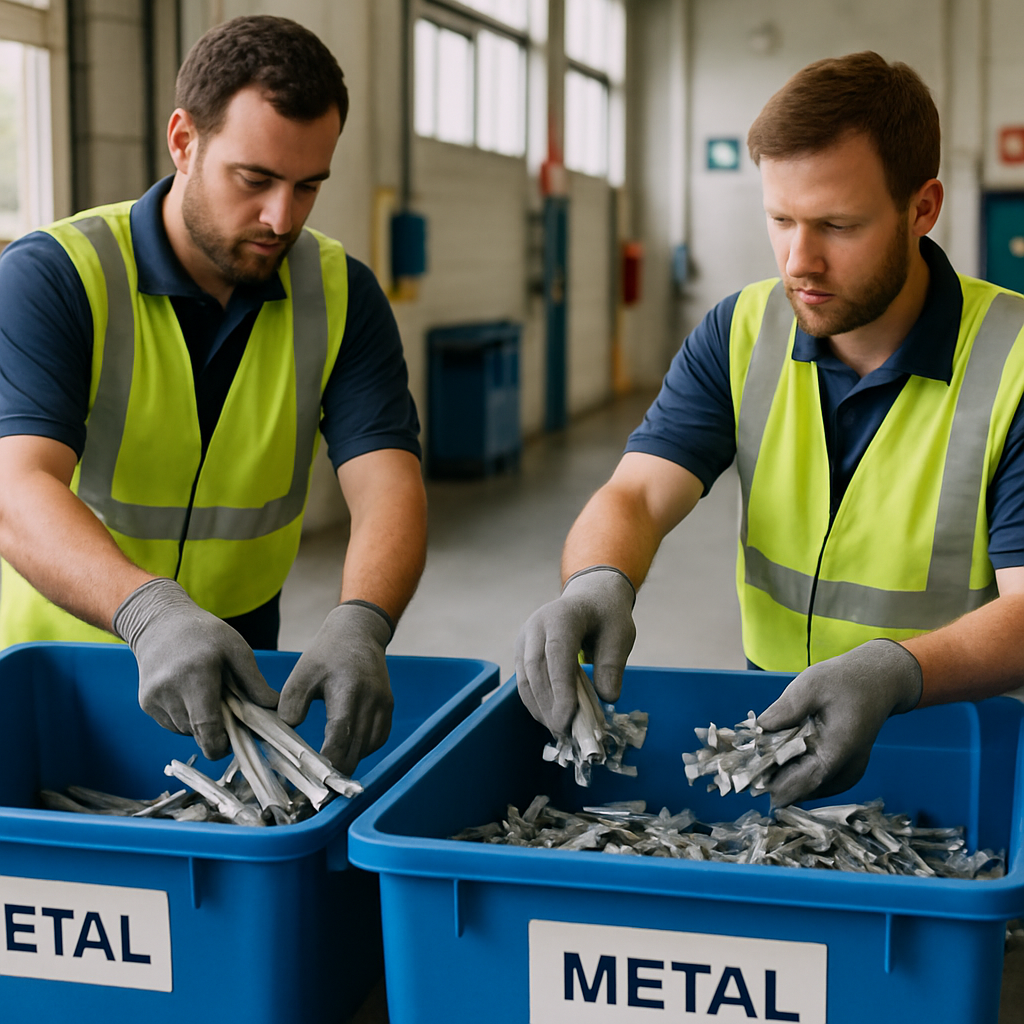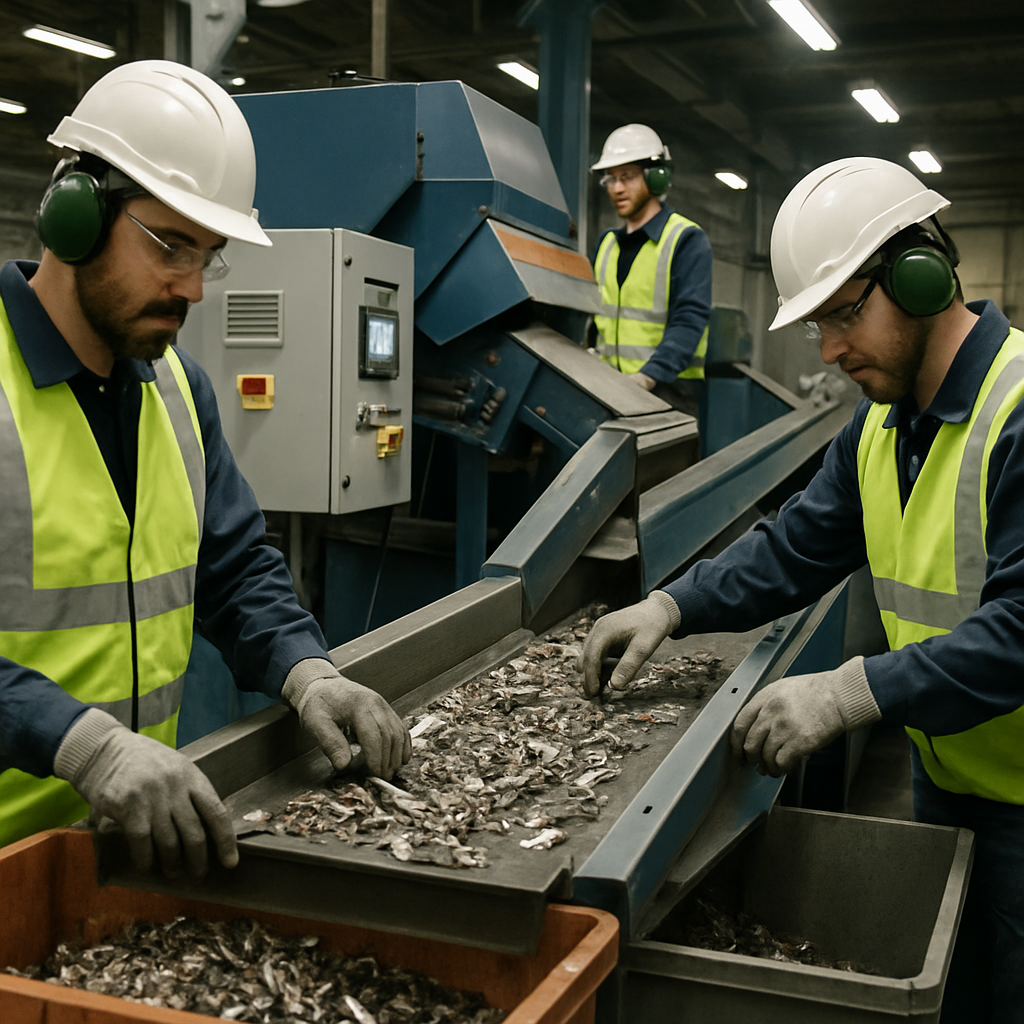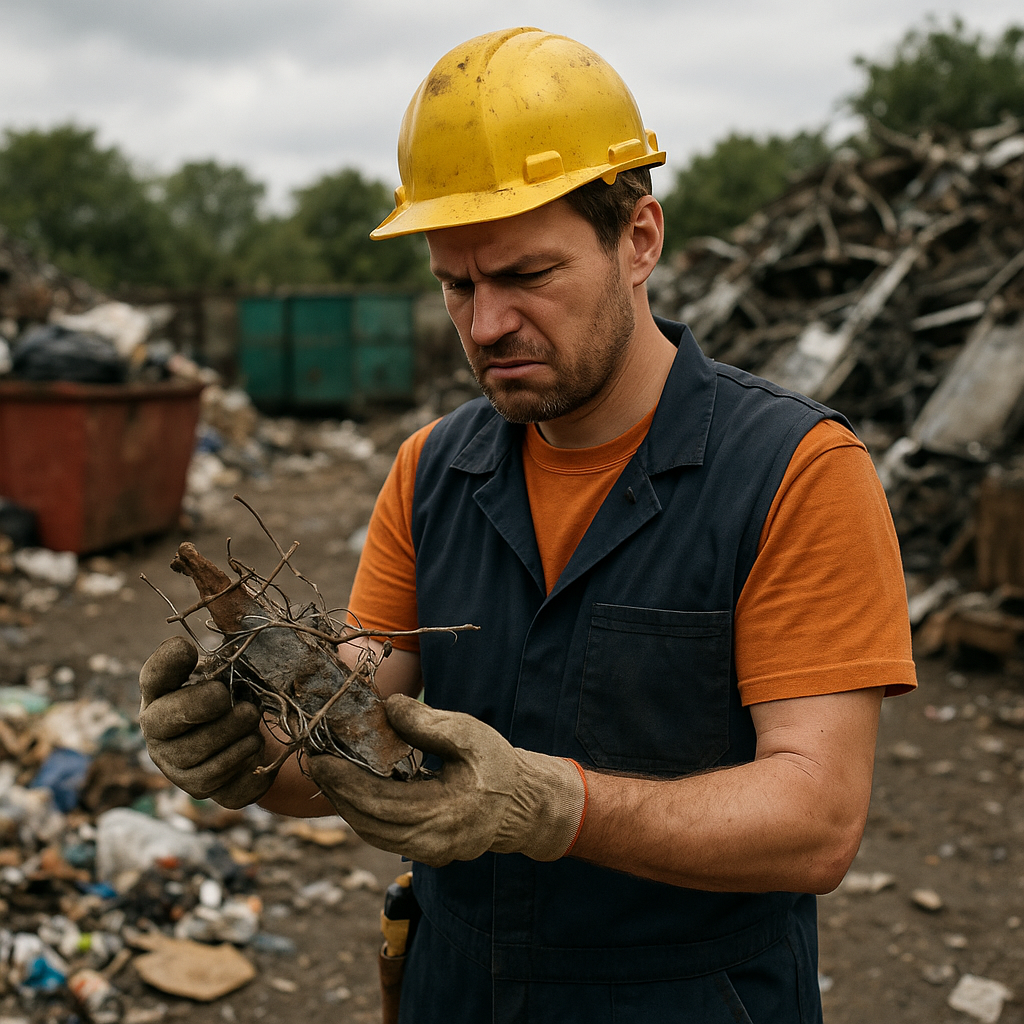5901 Botham Jean Blvd, Dallas, TX 75215
Zero Waste Metal Recycling: Benefits, Process & How to Implement
September 4, 2025Zero waste metal recycling represents a comprehensive approach to materials management where every scrap of metal is repurposed and reused. The goal is straightforward yet impactful: keep all metal materials in circulation and out of landfills. This practice forms a critical component of the circular economy model, which contrasts sharply with traditional linear consumption patterns.
In this sustainable system, metals don’t follow the typical take-make-dispose lifecycle. Instead, they remain in use indefinitely through continuous recycling and remanufacturing processes. Metals are particularly well-suited for this approach because most can be recycled repeatedly without degrading in quality or losing their essential properties.
The environmental benefits of zero waste metal recycling are significant. This approach conserves finite natural resources by reducing the need for raw material extraction. It substantially cuts energy consumption, with recycled metals requiring up to 95% less energy than processing virgin materials. The reduction in mining, processing, and manufacturing also results in lower greenhouse gas emissions and a smaller carbon footprint.
What Are the Key Benefits of Zero Waste Metal Recycling?

Zero waste metal recycling is a powerful tool against environmental degradation and resource depletion. Unlike many materials that degrade during recycling, metals can be repeatedly melted and reformed without losing their essential properties. This unique characteristic makes metals ideal candidates for zero waste initiatives.
The benefits of zero waste metal recycling extend far beyond keeping materials out of landfills. Let’s examine the significant advantages this practice offers to our environment, economy, and communities.
Landfill Waste Reduction
Recycling metals reduces the volume of waste entering landfills dramatically. Metals take centuries to break down and occupy valuable space in disposal facilities.
Scrap metal that could fill landfill space can instead be transformed into new products, maintaining its value and utility rather than becoming pollution.
Comprehensive metal recycling programs enable municipalities and businesses to cut waste management costs while extending landfill lifespans.
Lower Greenhouse Gas Emissions
Metal recycling significantly reduces carbon emissions compared to primary production methods. Mining virgin ore requires extensive energy for extraction, transportation, and processing, releasing large amounts of greenhouse gases.
Recycled metal production has a much lower environmental impact. Industry research shows that recycling steel results in an approximately 86% reduction in air pollution and uses about 40% less water compared to mining and processing virgin materials.
For aluminum, the benefits are even greater. Recycling saves up to 95% of the energy needed to produce new aluminum, significantly reducing carbon emissions.
- Steel recycling: 86% reduction in air pollution
- Aluminum recycling: 95% energy savings compared to new production
- Overall metal recycling: Significantly lower carbon footprint
Conservation of Natural Resources
Metal ore deposits are finite resources that become harder and more damaging to extract as accessible deposits deplete. Zero waste metal recycling helps preserve these resources for future generations.
Every ton of steel recycled conserves approximately 1.1 tons of iron ore, along with other minerals and virgin materials, extending the lifespan of existing metal reserves while reducing the environmental impact of mining.
Mining operations often lead to habitat destruction, soil erosion, and water contamination. Recycling reduces the need for new mining, helping to protect ecosystems and biodiversity.
| Metal Type | Energy Savings (%) | Resource Conservation |
|---|---|---|
| Aluminum | 95% | Saves raw bauxite extraction |
| Copper | 85% | Reduces need for copper mining |
| Steel | 60% | Conserves iron ore, coal, and limestone |
| Overall Impact | Up to 92% | Minimizes habitat destruction and pollution |
Energy Consumption Reduction
Manufacturing products from recycled scrap metal requires much less energy than processing raw ore. The energy savings vary by metal but are substantial across the board.
Recycling one ton of aluminum can save enough energy to power an average home for nearly a year. Even for metals with less dramatic savings, the energy reduction is significant.
These energy savings directly reduce fossil fuel consumption and lower manufacturing utility costs. Using recycled steel, for example, results in a 76% reduction in water pollution and 40% less water usage overall.
Economic Benefits and Job Creation
The metal recycling industry generates billions annually and supports hundreds of thousands of jobs across the collection, processing, and manufacturing chain. According to the Institute of Scrap Recycling Industries, the entire recycling industry contributes about $117 billion annually to the U.S. economy.
Recycling sector jobs often offer stable employment with good wages, creating positions across various skill levels, from collection and sorting to advanced manufacturing and engineering.
Using recycled metals often reduces production costs for manufacturers. These savings help businesses remain competitive while practicing environmental stewardship.
Support for a Circular Economy
Zero waste metal recycling is essential in the circular economy model. Metals can be recycled indefinitely without significant degradation, making them ideal for closed-loop systems.
This endless recyclability keeps metals in circulation, reducing reliance on virgin materials and minimizing waste. The circular approach turns what was once considered waste into a valuable resource reintroduced into the manufacturing process repeatedly.
Supporting zero waste metal recycling helps businesses and communities contribute to a more sustainable economic model that values resource efficiency and environmental protection.
Lower Consumer Costs
Manufacturers using recycled metals often realize cost savings that can be passed on to consumers. As metals become scarcer, their prices increase.
Recycling helps maintain a steady material supply, moderating price volatility and potentially reducing the cost of metal products. This benefit extends across numerous industries, from construction and transportation to consumer electronics and packaging.
Without robust recycling programs, the increasing scarcity of metal resources would lead to higher prices for everyday products that rely on these materials.
How is Zero Waste Metal Recycling Implemented?

Implementing zero waste metal recycling requires a systematic approach focused on recovering every possible ounce of metal. Modern metal recycling has evolved from basic collection to a sophisticated process using advanced technologies and methodical procedures. Success depends on integrating several key components into a seamless system.
Advanced Collection and Sorting Systems
The foundation of zero waste metal recycling begins with efficient collection methods. Industries use specialized containers and logistics systems to separate metals from other waste streams at the source. This prevents contamination and preserves material quality from the start.
Once collected, metals undergo automated sorting using a variety of technologies. Magnetic separators extract ferrous metals containing iron from the waste stream. These magnets pull steel and iron away, creating a clean ferrous stream for further processing.
For non-ferrous metals like aluminum, copper, and brass, recyclers employ eddy current separators. These machines create magnetic fields that repel non-ferrous metals, effectively separating them from other materials. The technology works by inducing electric currents in metal pieces, creating a magnetic reaction that pushes them away from the rest of the waste.
High-Tech Identification and Analysis
Precision in metal identification has dramatically improved with the adoption of X-ray fluorescence (XRF) analyzers. These devices analyze fluorescent energy signatures from scrap metal to instantly determine elemental composition, allowing recyclers to quickly identify specific alloys and metal types without destructive testing.
The data from XRF analysis allows for more precise sorting and increased metal purity. Recycling facilities can now separate metals that look identical to the human eye but have different compositions. This technology has been particularly valuable in sorting aluminum alloys, which can vary significantly in their material properties.
Artificial intelligence and computer vision systems also play crucial roles in modern sorting facilities. High-speed cameras paired with AI algorithms identify different metals based on visual characteristics like color, texture, and shape. These systems continuously learn and improve their recognition capabilities over time.
Processing for Maximum Recovery
After sorting, metals undergo specialized processing to prepare them for reuse. Shredding and size reduction equipment breaks down larger pieces into manageable sizes, increasing surface area and improving melting efficiency in subsequent steps.
Modern shearing machines use hydraulic power to precisely cut thick metal sections. These cuts prepare materials for further processing while preserving material integrity. The precision of these machines helps maximize recovery rates by minimizing material losses during processing.
Baling presses compact processed metals into dense, uniform packages for efficient transportation and storage. These machines reduce the volume of processed metals, optimizing logistics and reducing the carbon footprint of transportation.
Closed-Loop Systems and Industrial Integration
Many industries now implement closed-loop recycling systems where metal waste becomes the raw material for new production. These systems keep materials circulating within the manufacturing process rather than being discarded after a single use.
In closed-loop systems, manufacturers partner with specialized recycling facilities to process their specific metal waste streams. The recycler returns processed material to the manufacturer as production-ready input. This approach eliminates waste and reduces the need for extracting virgin materials.
Some forward-thinking manufacturers have integrated recycling directly into their production facilities. This on-site processing eliminates transportation requirements and allows immediate reuse of recovered materials.
| Technology | Description | Benefits |
|---|---|---|
| AI-powered sorting | Automated identification and separation of different metals | Increased accuracy, higher throughput, reduced contamination |
| Robotic systems | Handling and sorting of metal waste | Improved safety, 24/7 operation, consistent performance |
| Bioleaching | Metal recovery from low-grade ores and waste | Access to new metal sources, reduced environmental impact |
| Blockchain | Traceability and transparency in recycling supply chain | Enhanced trust, improved efficiency, better data management |
| 3D printing | Direct use of recycled metal powders | Reduced waste, customization, on-demand production |
Zero waste metal recycling requires ongoing innovation and investment. As technologies advance, the efficiency and completeness of metal recovery improve. Industries adopting these comprehensive approaches not only minimize their environmental impact but often realize significant cost savings through resource conservation and reduced waste management expenses.
What Challenges Does Zero Waste Metal Recycling Face?
Contamination Issues
Contamination remains a significant hurdle in achieving zero waste metal recycling. Recyclable metals often arrive with non-metallic materials like plastic, rubber, or hazardous substances attached, slowing down the recycling process. These contaminants require additional resources for separation and cleaning, increasing costs throughout the recycling chain.
Paint, coatings, and food residue pose particular problems for metal recyclers. Even a simple aluminum can with a steel lid complicates sorting. Different metals need separate processing streams; mixing them can create unwanted alloys, reducing the quality and value of the recycled material.
To tackle contamination challenges, advanced sorting technologies using artificial intelligence and robotics are emerging as effective solutions. These systems can identify and separate materials more accurately than traditional methods, enhancing the quality of recovered metals.
Infrastructure Limitations
Collection and processing infrastructure remains underdeveloped in many regions. Efficient metal recycling requires comprehensive collection networks to gather materials from diverse sources, yet many areas lack the necessary systems to collect, sort, and transport recyclable metals effectively.
Transportation costs significantly impact economic viability. Moving recyclable materials from collection points to processing facilities incurs substantial expenses, especially for low-value materials. These logistics challenges can undermine the financial sustainability of recycling operations.
Storage complications arise particularly with certain metal products. For instance, lithium-ion batteries with metal components pose fire risks if damaged or improperly stored. Safe handling requires specialized training and facilities, adding complexity and cost to the recycling process.
Collaborative efforts between municipalities, businesses, and recycling facilities are beginning to address these infrastructure gaps. Regional processing centers and improved transportation logistics can help create more efficient systems for metal recovery.
Technological Barriers
Current recycling technologies often struggle with complex metal products. Modern devices contain multiple metals and compounds that are difficult to separate efficiently. The intricate design of products like electronics makes recycling particularly challenging, as components are tightly integrated and require specialized processes to recover valuable materials.
Processing efficiency limitations exist with traditional recycling methods. Some techniques may not effectively capture all valuable materials, resulting in resource loss. This inefficiency is especially problematic for critical metals like cobalt, lithium, and rare earth elements used in advanced technologies.
Innovation in hydrometallurgical processes offers promising solutions. These water-based chemical processes can dissolve and recover specific metals with greater precision. Recent improvements have made these techniques more environmentally friendly, reducing water consumption and enabling selective metal recovery with high purity levels.
Economic Challenges
Market volatility creates unpredictable conditions for metal recycling operations. Prices for recycled metals fluctuate dramatically based on global economic conditions, making it difficult for facilities to maintain consistent profitability. During economic downturns, reduced demand for certain metals can significantly impact the stability of recycling businesses.
High initial investment costs present another barrier. Modern recycling facilities require sophisticated equipment for efficient material separation and processing. These capital expenditures can be prohibitive, especially for smaller operations trying to enter the market or upgrade capabilities.
Despite these challenges, the economic case for metal recycling continues to strengthen. As virgin material extraction becomes more expensive and environmental regulations tighten, recycled metals become more competitive. Industry collaborations and government incentives are helping to create more stable markets for recycled materials.
Regulatory and Safety Concerns
Evolving regulations create compliance challenges for metal recyclers. Environmental standards and waste management policies change frequently, requiring constant adaptation. Different regulations across regions complicate operations for companies working across multiple jurisdictions.
Worker safety concerns require ongoing attention. Recycling operations can expose workers to hazardous materials, dust, and physical dangers. Proper training, protective equipment, and safety protocols are essential but add operational complexity and cost.
Standardized guidelines for metal recycling are emerging to address these concerns. These include definitions of terms, targets to define success, accountability requirements, and equity provisions. Such standards help create a level playing field for recyclers while ensuring environmental and safety compliance.
The Path Forward Through Collaboration
The future of zero waste metal recycling depends on collaborative efforts across industries and stakeholders. Partnerships between scrap recyclers, manufacturers, governments, and non-governmental organizations yield more comprehensive solutions to these complex challenges.
Ongoing research into new recycling methods and technologies is essential for finding more efficient and effective ways to process various types of scrap metal. Educational initiatives aimed at businesses, individuals, and recycling professionals can significantly improve the quality of collected scrap.
While the challenges are significant, the transition toward zero waste metal recycling represents a crucial step in conserving resources and reducing environmental impact. Through innovation, collaboration, and investment in advanced technologies, the metal recycling industry is poised to overcome these hurdles and create a more circular economy for metals.
| Challenge | Details |
| Contamination Issues | Contaminants like plastic and rubber must be separated from metals, increasing costs. |
| Infrastructure Limitations | Many regions lack efficient collection and processing systems, impacting economic viability. |
| Economic Barriers | High initial technology costs and fluctuating recycled metal prices challenge financial sustainability. |
| Technological Barriers | Current technologies struggle with separating complex metal products, requiring advanced methods. |
| Regulatory and Safety Concerns | Constantly evolving regulations and safety standards can complicate operations. |
How Can Individuals and Businesses Contribute to Zero Waste Metal Recycling?

Metal recycling is a vital tool for building a circular economy. Unlike many materials, metals can be recycled indefinitely without losing essential properties. This makes metal waste reduction particularly impactful environmentally and economically.
Individual Contributions to Metal Recycling
Individual actions are crucial to successful zero waste metal recycling initiatives. Simple changes in household habits can lead to significant collective impact. Start by setting up a designated container for metal items at home, simplifying the sorting process.
When disposing of metal items, take time to separate different types. A basic sorting system distinguishes between ferrous metals (those containing iron, which attract magnets) and non-ferrous metals like aluminum, copper, and brass. This presorting improves recycling efficiency and increases the value of recyclable materials.
Learn about local collection programs in your community. Many municipalities offer curbside pickup for certain metal items or maintain drop-off locations for larger scrap. For items containing both metal and other materials, like electronics or appliances, look for specialized recycling services that can properly dismantle and sort components.
Business Recycling Strategies
Businesses can significantly influence metal recycling rates through systematic approaches. Start by conducting a waste audit to identify all metal waste streams in your operations. This assessment establishes a baseline for measuring improvement and highlights waste reduction opportunities.
Implement a comprehensive recycling policy outlining procedures for collecting, sorting, and recycling various metal materials. Train employees on these protocols and the importance of metal recycling. Understanding its environmental and economic benefits increases their engagement.
For manufacturing businesses, consider investing in equipment that minimizes metal waste during production. Modern cutting and fabrication technologies can significantly reduce scrap generation while improving efficiency. The initial investment often pays off through material savings and reduced disposal costs.
Partner with specialized recycling services that understand your industry’s specific metal waste challenges. These providers can offer customized solutions, including on-site collection bins, regular pickup schedules, and detailed reporting on recycling rates.
Creating a Zero Waste Culture
Building a culture that values metal recycling requires ongoing education and awareness efforts. Use clear signage near recycling stations showing what metal items can be recycled, with visual examples to prevent confusion. Regular reminders about proper recycling procedures help maintain engagement.
Share success stories that demonstrate the impact of your recycling initiatives. For example, recycling one ton of steel saves 2,500 pounds of iron ore, 1,400 pounds of coal, and 120 pounds of limestone. These tangible metrics help people connect their actions to meaningful outcomes.
Businesses can use their purchasing power to prioritize products made from recycled metals, thus creating market demand for recycled materials and completing the circular economy loop. Seek suppliers that use post-consumer metal content in their products and packaging.
Overcoming Common Recycling Barriers
Several challenges can hinder effective metal recycling efforts. Contamination is a major obstacle. Food residue, paint, or mixed materials can reduce recyclability. A quick rinse of food containers before recycling removes most contaminants without wasting excessive water.
Space constraints often limit recycling capabilities, especially in urban environments. Consider compact storage solutions like stackable bins or wall-mounted collection systems. For businesses, work with recycling partners to determine optimal container sizes and pickup frequencies based on space limitations.
Convenience significantly influences recycling participation rates. Make recycling as easy as disposal by placing containers in accessible locations throughout homes and workplaces. For businesses, position collection points near areas where metal waste is generated.
Innovative Approaches
Some organizations have developed creative solutions to boost metal recycling participation. Community collection events can make recycling a social activity while providing convenient drop-off opportunities. These events work well for items like electronics, which contain valuable metals but require specialized processing.
Educational workshops demonstrate proper recycling techniques and highlight the journey of recycled metals. These sessions can target specific audiences, such as school children, community groups, or business teams. Hands-on demonstrations leave lasting impressions about metal recovery’s importance.
Incentive programs that offer rewards for metal recycling can dramatically increase participation. Some scrap yards pay cash for valuable metals like copper and aluminum. Businesses can create internal recognition programs that celebrate departments or individuals with outstanding recycling performance.
Technology solutions like smartphone apps help people identify recyclable metals and locate nearby collection points. These tools reduce confusion about what can be recycled and make the process more accessible.
Measuring and Improving Impact
Tracking recycling efforts creates accountability and highlights areas for improvement. For households, keep a simple log of metal items recycled or note the reduced frequency of trash collection. Businesses should maintain more detailed records that quantify recycled materials by weight and type.
Set progressive goals to continuously improve metal recycling performance. Start with achievable targets, then gradually increase ambitions. Celebrating milestones helps maintain motivation and recognize progress.
Regular assessments help identify weaknesses in recycling systems. If certain metal items consistently end up in the trash, evaluate why and adjust your approach. Simple changes to container placement or clearer instructions can solve persistent problems.
Remember, zero waste is a journey rather than an immediate goal. Each properly recycled metal item contributes to resource conservation, energy savings, and pollution reduction. Through consistent individual and business efforts, we can significantly increase metal recycling rates and move closer to a truly circular economy.
Conclusion: The Future of Zero Waste Metal Recycling

Zero waste metal recycling is a crucial foundation for building a sustainable, circular economy. The transformation in the industry is not only promising but also impactful. As technologies like AI-powered sorting systems, blockchain-based traceability solutions, and green steel production methods evolve, achieving true zero waste in metal recycling becomes more attainable. These advancements are already reducing energy consumption, conserving natural resources, and minimizing the environmental impact of metal production.
The path to a sustainable future is clear. By embracing metal recycling, adopting green technologies, and developing ecosystems that support waste reduction and circularity, we can create a more resilient and resource-efficient future for generations to come. Whether recycling scrap steel or implementing hydrogen-based reduction processes, the metal industry can significantly reduce its carbon footprint while supporting economic growth. For your recycling needs and to be part of this sustainable movement, contact Okon Recycling at 214-717-4083.
